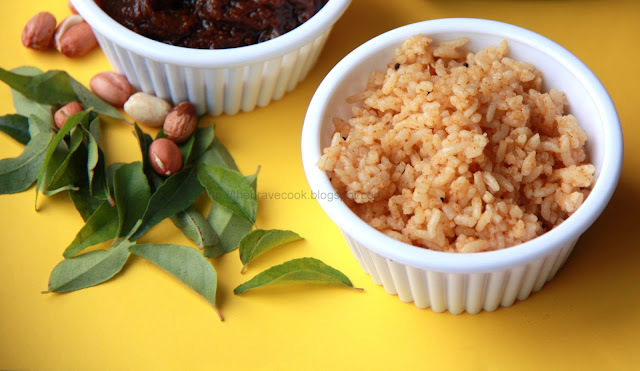Raise your hand if you DONT love puliyogre. Raise if your hand if you DO. There I see more participation now!
Sometimes I feel the hubby married me only to be assured of constant access to this delectable dish which is so near to any Iyengari's heart. My mother has had a dream run because all she had to say was "Puliyogre" to have him at her beck and call. He also coaxed her to send some of her gojju with us to the US. But the only thing I do not understand in all this hullabulloo is why the hubby heats it before eating it. Ever heard of eating hot puliyogre but thats the only way he likes it! Pulioygre is the rice dish of choice on any festival day or special occasion in an Iyengari house. An Iyengari wedding caterer is judged solely on his Puliyogre making calibre to get repeat contracts. The judgement is even passed as a whisper throughout the wedding hall so people who come in later batches to eat are already equipped with the knowledge of whether to skip all else to conserve space for the Puliyogre or to avoid it entirely.
Puliyogre can easily be the only dish for a meal or one of the main course dishes in a bigger meal. If the gojju is on hand, it is a breeze to make.
The Puliyogre gojju can be stored in air tight containers for upto a month. I keep it in the fridge sometimes but my mom never does and it does not grow mold or go bad.
Iyengari Puliyogre Gojju
Servings: Fills 1 Mason Jar/ Kissam Jam bottlePrep Time: 2 - 4 hrs Cook Time: 1 hr
Ingredients
200 gms Tamarind (should yield 1.5 cups of juice)3-4 cups of water
3/4 cup Sambhar powder or Rasam powder
3/4 cup Jaggery shavings
For Seasoning
3/4 cup Oil1 1/2 tsp Mustard seeds
1 tsp Turmeric
4 Red Chillies
3-4 tsp Channa Dal
2 tsp Hing/Asafoetida
10-15 Curry leaves
Instructions
- Wash and soak tamarind in the water for 4 hours till it softens enough to squeeze to get the pulp.
- Alternately wash and soak in water and microwave for 30 min bursts 2-3 times till it softens. Continue to soak for around 2 hours and then squeeze to get the pulp.
- Do NOT add too much water in the soaking process, else it takes a longer time to get the gojju consistency later.
- Squeeze to get the pulp and then filter it using a tea filter (I found this easier) or cloth to get 1.5 cups of tamarind juice. It is a process which requires patience so have your favourite music on if that helps.
- Once you have the filtered juice from all the pulp and if it is not yet 1.5 cups, add half a cup of water to the pulp, squueze some more, filter and get more juice.
- If you have gotten this far, the tough part of the recipe is over so relax.
- Heat oil in a heavy bottomed vessel and mustard seeds to it.
- Once the mustard seeds splutters add all the seasoning ingredients one by one in the same order listed above.
- Fry for a minute making sure that the channa dal does not over brown.
- Reduce the flame to low.
- Now add the tamarind juice to it slowly. It is best to slide it down the side of the vessel to avoid oil spurts.
- Stir the mixture and allow to boil.
- Once it boils add the Sambhar/Rasam powder.
- Mix thoroughly.
- Add the jaggery and mix thoroughly.
- The mixture would have thickened by now but continue to boil while stirring occasionally.
- It is done when it reaches the consistency of a thick gojju or idli batter. It takes approximately 40 minutes to get to this state
- Allow it to cool completely on the counter top before storing it in an air tight container.




No comments:
Post a Comment